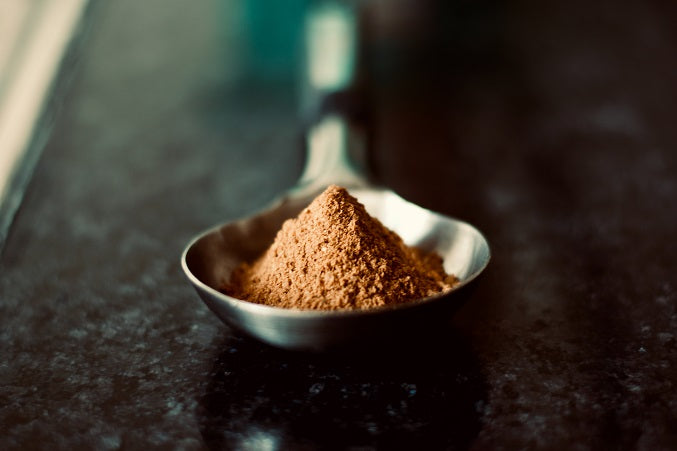Whether you have heard the term – Dutch Process Cocoa or not, we are sure that you have consumed this cocoa powder in in some form or the other. While this term may not be known to all, the kind of cocoa powder it refers to is fairly common.
The Dutch Process refers to treatment of cocoa solids with Potassium Carbonate to neutralize their acidity. The process gets its name from the Dutch chocolate maker Coenraad Johannes van Houten who devised it. To understand the process, we have to go to the preceding step which interestingly was devised by Coenraad’s predecessor – his father, Casparus. Casparus was responsible for formulating the process of separating the cocoa solids and cocoa butter using a hydraulic press. Today, it is a common practice for chocolate manufactures to remove most of the cocoa butter from the cocoa mass. What remains after removing the cocoa butter is the cocoa solids. Since cacao is a naturally acidic fruit, the beans are also acidic and even after their fermentation, drying, conching (grinding) and removal of cocoa butter, they retain their acidity.
On an average the ph of cocoa solids ranges between 5 to 6. All substances that have a ph below 7 are acidic. A ph of 7 is neutral and it is also the ph of water. Substances that have a ph of above 7 are called bases. Potassium Carbonate is a base (more particularly, an alkali – which is a type of base that is soluble in water) and when cocoa solids are treated with it, the reaction leads to neutralization of the acidity of the cocoa solids. We bet this takes you back to your chemistry lessons on acids, bases and salts in school. But, that’s exactly what we find most fascinating about food. It is as much about chemistry as it is about ingredients, flavors, taste etc.
There are multiple reasons why manufacturers adopt the dutch process. The first and foremost is what we discussed above - it neutralizes the acidity of cocoa solids, thereby making its taste milder and mellow. The process also changes the colour of the cocoa solids / powder to a deeper brown. When used in recipes, this cocoa powder lends the dish an intense color that we often associate with chocolate. The process also makes the cocoa powder easily soluble in liquids.
These reasons to employ this process may appear to be quite valid and you may ask that if it supposedly improves the cocoa powder, what is wrong with it? Well, we would say – A lot!
One thing that we must remember is that the dutch process cocoa powder is essentially cocoa solids i.e., cocoa butter has been removed from it. So, it has already lost its richness. Thereafter, it is washed with a chemical agent to substantially alter its taste and color. The result is that this type of cocoa powder ends up being heavily processed and devoid of any natural goodness of cacao.
A cacao bean is a marvelous gift of nature which is rich in flavour, minerals and nutrients. It is not a surprise that the ancient Aztecs and Mayans considered it sacred, offered it to the gods and consumed it with reverence for its medicinal and healing properties. However, owing to the industrialization and mass production of chocolate, we have never received its benefits. It is only now, with the bean to bar movement taking off across the world that we are waking up to the benefits of cacao. Some of the minerals found in cacao are magnesium, zinc, iron, phosphorus etc. which are all essential for hormonal health. Further cacao is rich in phytonutrients which are chemicals present in plants that play a role in boosting immunity and preventing diseases. Cacao is rich in the phytonutrient known as – Flavonoid.
Flavonoids (along with another phytonutrient – Carotenoid) are what give fruits their vibrant colours. Cacao is rich in a subcategory of flavonoids, known as flavanols. These flavanols are friendly nutrients that are known to improve brain functioning, reduce blood pressure, insulin resistance, improve cardio vascular health etc. since we are no medical experts, we will stop here with all the health benefits of cacao. But we definitely are chocolate makers, deeply invested in the flavours of cacao and celebrating them in whatever we make.
The cacao fruit is nothing short of a marvel and there are literally multitudes of flavors packed in each tiny bean. In fact, cacao has more flavor compounds than even wine which is dwelled upon with all seriousness in tasting and appreciation sessions. The flavors of cacao depend on multiple factors, for instance, the region in which it is grown, the trees that grow alongside the cacao tree, the care that is given to the tree and the fruit, fermentation, roasting and many more. However, industrial processes like the removal of cocoa butter from the cocoa mass and the dutch process are responsible for eliminating most of the subtle flavours and nuances of natural cacao as well as its nutritive value. What remains after, is a cocoa powder that is homogenized and flattened to suit the convenience of mass production. It is this cocoa powder which we then consume in almost all chocolate products, be it chocolate bars, cakes, drinking chocolate or ice creams.
It is a matter of great disappointment, that since the taste of the dutch process cocoa powder has dominated our palate for so many years, we have now started believing that that’s how chocolate ought to taste and the taste of a bar of chocolate made with natural cacao takes effort to appreciate This, however, is gradually changing and that gives us hope.
So, if you were to make a change in the way you consume chocolate or would simply like to identify dutch process cocoa powder to make a more informed choice, here is how to spot it. Dutch process cocoa powder, could also be referred to as “Alkalized Cocoa Powder” of “European Style cocoa powder” in the ingredient information printed on products. In India there is no specific requirement to disclose whether the cocoa powder used in the product is alkalized / dutch process cocoa powder or not. If you want to steer clear of it, then the best way is to look for products that disclose that they use natural, non-alkalized cocoa. If you are consuming chocolates / chocolate products created by chocolate makers that make them from scratch, i.e., from the cacao beans, as is in our case, you are automatically avoiding the dutch process cocoa.
There, however, is a predicament you might face if you have any interest in baking. Most recipes mention if they require natural cocoa powder or dutch process cocoa powder. Substituting dutch process cocoa powder with natural cocoa powder could be tricky, but it is possible. It may also require you to go back to the same chemistry lesson on acids, bases and salts. One of the most important adjustments that you must remember, is the choice of leavening agent, i.e., the ingredient that causes the dish to rise. The most common types of leaving agents are probably sitting on your kitchen shelf right now – i.e., baking soda or baking powder.
Dutch process cocoa powder being neutral in nature does not react with baking soda which is a base and requires baking powder to react with for the dish to rise. Similarly natural cocoa powder when used in a recipe that calls for only baking powder, may not fare very well. If the recipe calls for both, baking soda and baking powder, it is better to stick to the kind of cocoa powder the recipe prescribes or you could experiment and come up with your own proportions. If the recipe does not mention the specific type of cocoa powder, then in all likelihood, it was created to work with either. While in everything we bake, we use our own dark chocolate, we are also aware that baking (or any kind of cooking) also kills the nutrients and flavor profiles of cacao. So, you could spare yourself the stress of substituting the ingredients and simply follow the recipe. That is perfectly alright since in any case, you are not going to get much benefit out of natural cacao if you bake it.
As chocolate makers, we are most concerned about the use of cacao in chocolate and chocolate drinks. It is in these products that cacao can truly shine and its flavours gets the center stage. A bar of chocolate made out of natural, unprocessed cacao will far exceed in taste, flavour, notes and texture as compared to the one that uses dutch process cocoa powder. For all these years, we have been kept from tasting the splendor of cacao owing to industrialization of chocolate. There is nothing wrong with the use of dutch process cocoa powder, so long as the decision to use has been backed by information and knowledge. But, the thing about processed foods is that the companies manufacturing them systematically keep the consumers from obtaining full knowledge about them. So, most often, consumption of processed food is with only partial information about it and so long as we keep consuming highly processed food with little or no information, we will keep perpetuating the cycle of heavy processing and uninformed choices which eventually impact our overall health.
So, let’s make reading the labels a habit and make more informed and better choices.


Share:
What’s in your hot chocolate?
Different varieties of chocolate